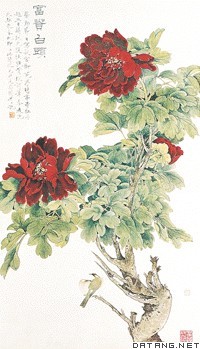1) New-style meticulous brush painting


新型工笔画
2) novel realistic figure painting


新工笔人物画
3) Chinese elaborate-style painting


工笔国画
1.
In Chinese porcelain art field, Chinese elaborate-style painting is an important part of Chinese classical art, and it plays an important role in creating art style, cultural grade, artic thoughts, aesthetic characteristics of Chinese porcelain.
在中国陶瓷艺术领域,中国工笔国画是中国古典艺术的一个重要组成部分,在塑造中国陶瓷的艺术风格、文化品位、艺术思想、审美特征上,起到了非常重要的作用。
4) meticulous painting


工笔画
1.
They share, to some degrees, same or similar application in some places: Tangkas Painting and traditional meticulous painting both fully employ the primary color system of red, yellow, blue, white and black; while application of colors in them reflect a totally diff.
藏族的唐卡绘画与汉地的传统工笔画分属我国绘画体系中两个不同的支系。
2.
Before the appearance of painting of man-of-letters of song yuan,meticulouspainting is the main form of Chinese tradition painging, the general viewpoint thinks that it does not have "intention" in meticulous painting and only painting of freehand brushwork has .
在宋元文人画出现之前,工笔画是中国传统绘画的主要表现形态,一般观点认为只有写意画才有“意”而工笔画中没有“意”的存在。
5) Fine Brushwork painting


工笔画
1.
On the relationship of freehand brushwork and fine brushwork paintings in image expression;
试论意笔画、工笔画的意象表达
2.
Ink and Wash painting evolves from Fine Brushwork painting, which serves as the source of the Ink and Wash painting in terms of expression techniques, theorctic basis and principles of modeling, as well as aesthetic approach.
工笔画是水墨画得以产生的艺术基础,水墨画从工笔画中走来,它的艺术审美思想,理论基础,造型原则都出自工笔画,其艺术表现技法也是从工笔画基础上发展而出。
6) The traditional Chinese realistic painting


工笔画
1.
The traditional Chinese realistic painting has long developing history that keeps unique artistic language, style and feature.
中国工笔画有着悠久的历史,在长期的发展过程中一直保持着独特的艺术语言和风貌。
2.
The traditional Chinese realistic painting has the huge history.


毛笔是工笔画的基本工具。
补充资料:工笔
| 工笔 中国画表现手法之一。与之相对应的是写意。工笔画法出现较早,远在魏晋时期就被画家采用,并成为主要的或唯一的表现技法。像顾恺之的《洛神赋图》、《列女仁智图》就是用工笔画法创作的。隋唐至五代两宋,工笔画法得到了长足的发展,并日趋成熟。
工笔作为一种绘画技法,一般是在经矾水加工过的熟宣纸或熟绢上,用工细流畅的墨线勾勒出所画物象的轮廓,也称白描稿,然后用淡墨或色笔染出物象的阴阳向背,在此基础上染一层底色,一般是石绿用赭石作底色,石青用花青作底色,等等。底色染好后可正式上色。因设色重轻、浓淡、厚薄的不同,工笔又分为工笔重彩和工笔淡彩。不管是淡墨晕染,或是染底色,正式上色,都要在每着一笔墨或色后,用含有清水的毛笔晕染一次,以冲开墨或色的痕迹,而且要反复进行,即俗称的三晕九染。因在晕染设色过程中覆盖了部分轮廓线,因此,待最后一次色着完后,要视所绘物象的不同,用墨或色依原轮廓线重勾一遍,这样可使线与色融为一体。待全部完成后,如果仍感到画面色彩厚度或深度不够,可在画背面用淡墨水或色重染一至数次。工笔画法要求线条工稳、细致、流畅,色彩匀净、明丽、典雅,所画物象造型准确生动逼真。工笔表现范围较宽,多用于人物画、花鸟画、山水画中的青绿、金碧及以楼阁建筑为题材的界画。除卷轴画外,工笔画法在古代壁画中也大量使用。 |
说明:补充资料仅用于学习参考,请勿用于其它任何用途。
参考词条
